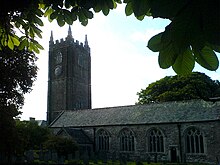Human settlement in England
Egloshayle
| |
|---|---|
 The Old Bridge at Wadebridge The Old Bridge at Wadebridge | |
 | |
| Population | 406 (United Kingdom Census 2011) |
| OS grid reference | SX001719 |
| Civil parish |
|
| Unitary authority | |
| Ceremonial county | |
| Region | |
| Country | England |
| Sovereign state | United Kingdom |
| Post town | WADEBRIDGE |
| Postcode district | PL27 |
| Dialling code | 01208 |
| Police | Devon and Cornwall |
| Fire | Cornwall |
| Ambulance | South Western |
| UK Parliament | |
| 50°30′47″N 4°49′16″W / 50.513°N 4.821°W / 50.513; -4.821 | |

Egloshayle (pronounced "eglos-hale"Cornish: Eglosheyl – eglos meaning church and heyl meaning estuary) is a civil parish and village in north Cornwall, England, United Kingdom. The village is beside the River Camel, southeast of Wadebridge. The civil parish stretches southeast from the village and includes Washaway and Sladesbridge.
History
Egloshayle was a Bronze Age settlement and later a river port, rivalling Padstow 5 miles (8 km) downriver. The trade consisted of tin, clay, wool, and vegetable crops. Egloshayle is now a residential suburb of Wadebridge.
Wadebridge developed in the parishes of Egloshayle and St Breock. A vicar of Egloshayle named Thomas Lovibond was responsible for the construction of the first bridge across the River Camel to replace a dangerous ford. Begun in 1468 and completed in 1485, the bridge was traditionally, but inaccurately, known as the "Bridge on Wool", as its foundations were said to be wool sacks. The bridge is, in fact, conventionally constructed with its foundations on the river bedrock. It is thought by some local historians, however that the bridge was completed by 1475, by a John Lovibond.
Churches
The parish church, which is Grade I listed, is named after St Petroc and is constructed almost entirely in the Perpendicular style. It has a Norman font, a stone pulpit dating from the 15th century, and also has a fine monument to Dame Barbara Molesworth (ob. 1735). There is a peal of eight bells: the tenor bell weighs 12-1-25.
The Anglican chapel at Washaway, dating from 1883, has a font which is one of the earliest in the county. Arthur Langdon (1896) recorded that there were six stone crosses in the parish, including two in the parish churchyard and one at Washaway. Three-hole Cross is about 1.5 miles (2.4 km) north of Egloshayle at a crossroads. (Another cross is described at Pencarrow.)
The bell-ringers of the village are celebrated in the song The Ringers of Egloshayle. The song has been recorded by, amongst others, the Cornish singer Brenda Wootton.
Notable buildings and antiquities
Local private properties of interest include Pencarrow House (18th century) and Croan House (17th century), each of which have seven bays. Kelly Rounds (or Castle Killibury) is an Iron Age fort on the border of the parish and has been associated with the legend of King Arthur.
One of the houses on the Egloshayle road overlooking the River Camel is Grade 2 listed.
Cornish wrestling
Cornish wrestling tournaments have been held in Egloshayle at Hingham Mill.
Notable people
Plant collecting brothers William and Thomas Lobb, spent their early life at Egloshayle.
Arthur Hamilton Norway (1859–1938), who became head of the Post Office in Ireland before the First World War, and the father of novelist Nevil Shute, was born in the village.
References
- BBC Pronouncing Dictionary of British Names; new ed., edited and transcribed by G. E. Pointon. Oxford: Oxford University Press, 1983; p. 84
- Place-names in the Standard Written Form (SWF) Archived 2013-05-15 at the Wayback Machine : List of place-names agreed by the MAGA Signage Panel Archived May 15, 2013, at the Wayback Machine. Cornish Language Partnership.
- Ordnance Survey: Landranger map sheet 200 Newquay & Bodmin ISBN 978-0-319-22938-5
- "Wadebridge cycle the Camel Trail to Padstow". www.cornishlight.co.uk. Retrieved 30 October 2018.
- "Egloshayle Church". BritishListedBuildings.co.uk. Retrieved 10 August 2021.
- Dove, R. H. (1982) A Bellringer's Guide to the Church Bells of Britain and Ringing Peals of the World, 6th ed. Aldershot: Viggers
- Langdon, A. G. (1896) Old Cornish Crosses. Truro: Joseph Pollard
- "An Old Cornish Song, The Egloshayle Ringers". Archived from the original on 18 September 2013. Retrieved 15 August 2012.
- Pevsner, N. (1970), Cornwall, 2nd ed. Penguin Books
- "108, Egloshayle Road". BritishListedBuildings.co.uk. Retrieved 10 August 2021.
- Cornish Guardian, 4 September 1969.
- "CORNWALL GARDENS TRUST » Journal » Lobb's Cottage". www.cornwallgardenstrust.org.uk. Retrieved 30 October 2018.
- 1901 Census of England and Wales
Further reading
- Maclean, John (1872–79) The Parochial and Family History of the Deanery of Trigg Minor. 3 vols. London: Nichols & Son
External links
![]() Media related to Egloshayle at Wikimedia Commons
Media related to Egloshayle at Wikimedia Commons
| Cornwall Portal | |
| Unitary authorities | |
| Major settlements (cities in italics) |
|
| Rivers | |
| Topics | |